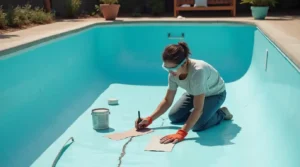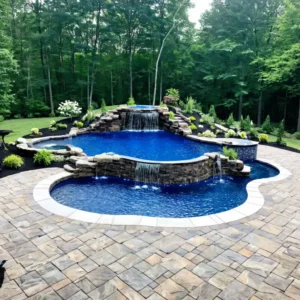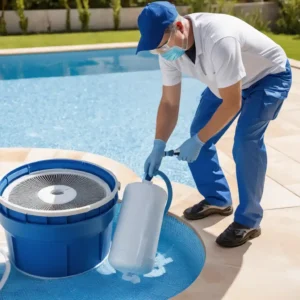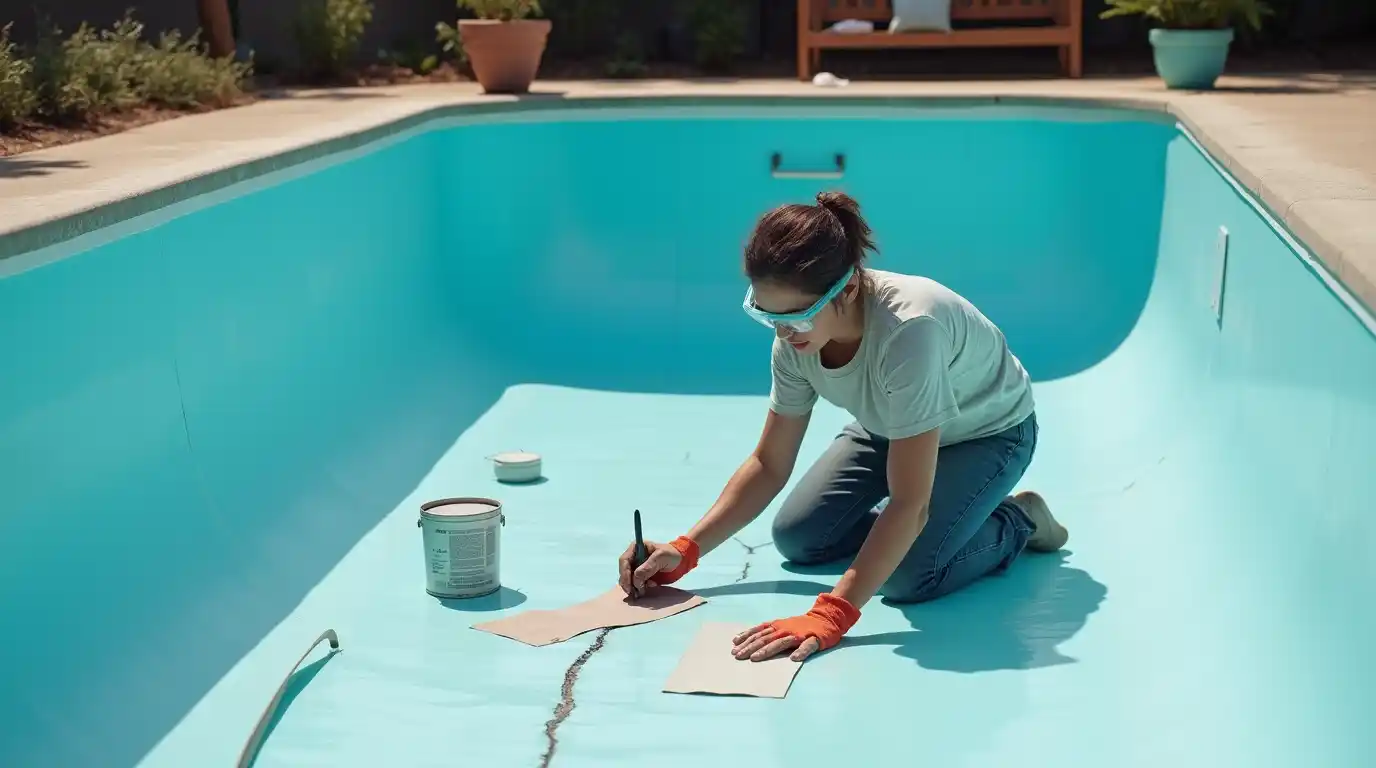Owning a fiberglass swimming pool is a dream come true for many homeowners. These pools are durable, low-maintenance, and visually appealing. However, like any other investment, they require care and occasional repairs. Whether it’s a small crack, stubborn stain, or worn-out coating, addressing these issues promptly can save you from costly problems down the line. In this article, we’ll guide you through everything you need to know about fiberglass swimming pool repair —from understanding common issues to completing DIY fixes using the right epoxy kit—all while keeping costs in check.
Why Choose DIY for Fiberglass Swimming Pool Repair?

When faced with damage to your fiberglass pool, you might wonder whether to hire a professional or tackle the issue yourself. While hiring an expert certainly has its perks, opting for a DIY approach provides several significant advantages:
Cost Savings: First and foremost, professional repairs can be expensive. By taking the DIY route, you eliminate labor fees and, in some cases, even reduce material costs.
Convenience: Moreover, with DIY repairs, you have the flexibility to work at your own pace. You won’t have to wait for an appointment, allowing you to get started right away.
Skill Development: Additionally, learning how to repair your pool equips you with valuable skills for future maintenance. This knowledge can prove beneficial long after the initial repair is complete.
For those who enjoy hands-on projects, DIY fiberglass swimming pool repair is not only rewarding but also practical. With the right tools and guidance, even beginners can achieve professional-quality results.
2.1 Benefits of DIY Fiberglass Pool Repair
- Affordable: First and foremost, you can save hundreds (or even thousands) of dollars compared to hiring a professional. Not only does this make it more budget-friendly, but it also allows you to allocate funds elsewhere.
- Customizable: Additionally, DIY repairs allow you to tailor the process to fit your specific needs and preferences. This flexibility ensures that you can address issues the way you see fit, without compromises.
- Satisfaction: Most importantly, there’s nothing quite like the sense of pride and accomplishment that comes with fixing something yourself. It’s incredibly rewarding to see the results of your hard work, and the satisfaction of a job well done is unmatched.
2.2 Tools You’ll Need for DIY Fiberglass Swimming Pool Repair
Before diving into repairs, gather the necessary tools:
- A high-quality fiberglass pool repair kit (includes epoxy resin and hardener).
- Sandpaper or a grinder for surface preparation.
- Brushes or rollers for applying epoxy.
- Safety gear like gloves, goggles, and masks.
- Optional: A pool skimmer to remove debris before starting.
Keywords like fiberglass pool repair epoxy and fiberglass repair kit will help you find the best products online or at your local hardware store.
Common Issues with Fiberglass Pools That Require Repair
Understanding what can go wrong with your fiberglass pool is key to preventing further damage. Here are some frequent problems—and why they matter:
- Cracks: Often caused by shifting soil, poor installation, or heavy impacts.
- Stains: Mineral deposits, algae growth, or chemical imbalances leave unsightly marks.
- Chips or Scratches: These can compromise the protective gel coat layer.
- Leaks: Small cracks may lead to water loss over time.
Ignoring these issues can result in structural damage or costly replacements. Let’s explore two major concerns in detail.
3.1 Do Fiberglass Pools Crack? Causes and Prevention

Yes, fiberglass pools can crack—but don’t panic just yet! Cracks typically occur due to several factors, including:
- Ground movement during freeze-thaw cycles, which can cause the pool structure to shift.
- Improper backfilling during installation, leading to uneven pressure on the pool’s surface.
- Excessive pressure from surrounding structures, which can put undue stress on the fiberglass.
To prevent cracks, however, there are steps you can take:
- First, ensure proper drainage around the pool area to prevent water from accumulating and causing damage.
- Additionally, avoid placing heavy objects near the pool edges, as they can exert pressure on the fiberglass.
- Lastly, make it a habit to regularly inspect your pool for early signs of wear or damage. This proactive approach can help you catch issues before they worsen.
By staying vigilant and taking these precautions, you can significantly minimize the chances of needing extensive fiberglass swimming pool repairs down the line.ol repair later on.
3.2 Dealing with Stains and Coating Damage in Fiberglass Pools
Stains often appear as discoloration on the pool surface. They’re usually harmless but can detract from the aesthetic appeal. To address them:
- Use a mild abrasive cleaner for mineral stains.
- Apply specialized coatings to restore shine and protect against UV rays.
If the gel coat—the smooth outer layer—is damaged, it’s essential to fix it quickly. Left untreated, exposed fiberglass fibers can weaken the structure and cause leaks.
Step-by-Step Guide to DIY Fiberglass Swimming Pool Repair

Now that you understand the “why” and “what,” let’s move on to the “how.” Follow these steps to repair your fiberglass pool effectively:
4.1 Preparing the Area for Repair
Proper preparation ensures long-lasting results. Start by:
- Draining the affected area if working below the waterline (consider using underwater adhesives for minor fixes).
- Cleaning the surface thoroughly with soap, water, and a scrub brush.
- Sanding the damaged spot until it’s smooth and free of loose material.
This step is crucial because any dirt or debris left behind can interfere with the bonding process.
4.2 Applying the Fiberglass Pool Repair Epoxy
Once the area is prepped, mix your epoxy according to the manufacturer’s instructions. Then:
- Apply a thin, even layer of epoxy using a brush or roller.
- Allow the first coat to dry partially before adding a second layer for extra strength.
- Smooth out any uneven areas with a putty knife.
Remember, patience is key here. Rushing the application can compromise the quality of the repair.
4.3 Finishing Touches and Curing Time
After applying the epoxy:
- Let it cure completely (usually 24–48 hours).
- Sand down rough spots once the epoxy hardens.
- Reapply a protective coating to enhance durability and appearance.
With these steps, your fiberglass swimming pool repair should look seamless and last for years.
How to Choose the Right Fiberglass Swimming Pool Repair Kit
Not all repair kits are created equal. When shopping for one, keep these factors in mind:
- Compatibility: Ensure the epoxy works well with fiberglass surfaces.
- Durability: Look for kits designed for long-term use.
- Ease of Use: Beginner-friendly options often include detailed instructions.
5.1 Top Features to Look for in a Fiberglass Pool Repair Kit
- Waterproof adhesives that resist chemicals and UV exposure.
- Comprehensive contents (e.g., epoxy, sandpaper, mixing cups).
5.2 Recommended Kits for Beginners and Professionals
Some popular brands worth considering include XYZ Pool Repair Kit and ABC Fiberglass Fixer. Both offer excellent value for money and reliable performance.
Fiberglass Swimming Pool Repair Cost Breakdown
One of the biggest advantages of DIY repairs is cost savings. Here’s a breakdown of potential expenses:
- Materials: A basic repair kit costs 50–150, depending on size and brand.
- Labor: Zero, since you’re handling it yourself!
- Professional Repairs: Hiring a contractor could set you back 500–2,000+.
Clearly, taking the DIY route makes financial sense.
6.1 Factors Affecting the Cost of Fiberglass Pool Repairs
- Size and severity of the damage.
- Accessibility of the repair site.
- Quality of materials used.
6.2 Long-Term Savings with Proper Maintenance
Regular upkeep reduces the likelihood of major repairs. Simple tasks like cleaning filters and balancing chemicals extend your pool’s lifespan significantly.
Tips for Maintaining Your Fiberglass Pool After Repair
Once your pool is repaired, focus on maintaining its condition. Here are some tips:
- Clean regularly to prevent stains and buildup.
- Check pH levels weekly to avoid corrosion.
- Inspect for new cracks or chips annually.
Using keywords like pool liner , deck , and hydrochloric acid , ensure you address all aspects of pool care.
Final Thoughts: Empower Yourself Through DIY Fiberglass Pool Care
Repairing your fiberglass swimming pool doesn’t have to be intimidating. With the right tools, knowledge, and determination, you can save money and take pride in maintaining your backyard oasis. Remember, prevention is always better than cure—so stay vigilant and proactive about pool maintenance.
Ready to roll up your sleeves? Grab a top-notch fiberglass swimming pool repair kit today and get started!
- DIY Fiberglass Swimming Pool Repair: Save Money with the Right Epoxy Kit & Cost Breakdown

- In Ground Pool Installation: Costs, Materials, and Landscaping.

- Pool Filter Maintenance: How to Keep Your Water Crystal Clear

FAQs About Fiberglass Swimming Pool Repair
Q1: Can I repair my fiberglass pool underwater?
A: Yes, certain epoxy kits are designed for underwater applications. Follow the manufacturer’s guidelines carefully for best results.
Q2: How much does it cost to repair a fiberglass pool professionally?
A: Costs vary based on the extent of the damage but typically range from 500to2,000 or more.
Q3: What causes fiberglass pools to crack?
A: Common causes include ground movement, poor installation, and excessive weight near the pool edges.
Q4: Is it safe to DIY fiberglass pool repairs?
A: Absolutely! As long as you follow safety precautions and use quality materials, DIY repairs are safe and effective.
Q5: How long does a fiberglass pool repair last?
A: Properly executed repairs can last several years, especially when paired with regular maintenance.

